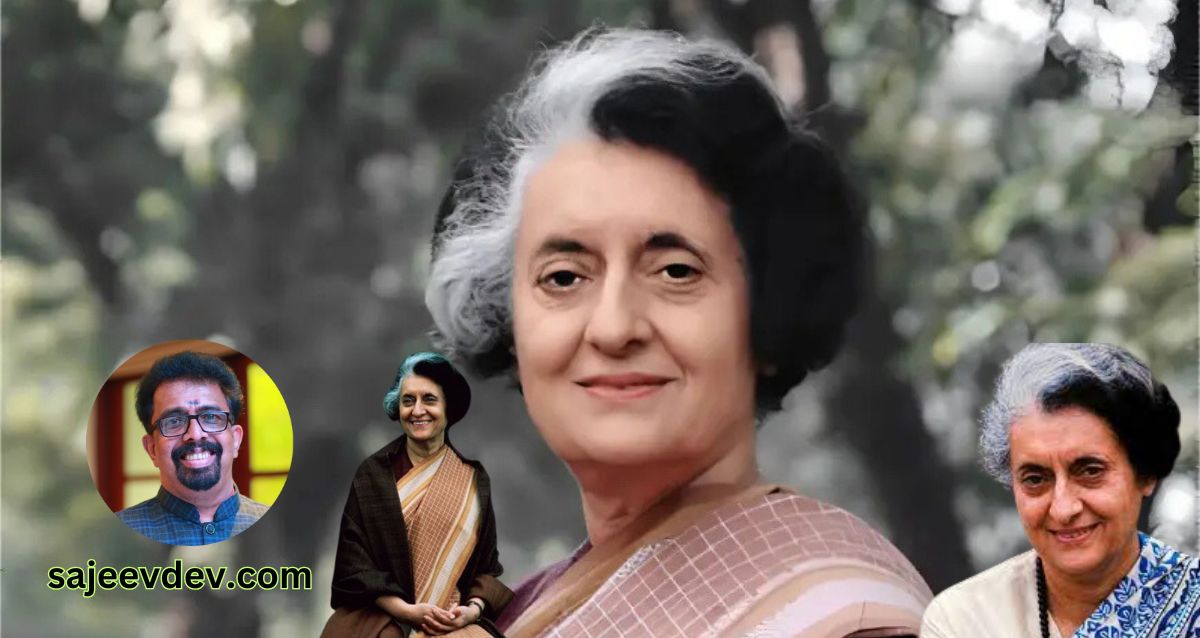Indira Priyadarshini Gandhi, born on November 19, 1917, in Allahabad, India, emerged as one of the most significant political figures in the country’s history
Indira Priyadarshini Gandhi, born on November 19, 1917, in Allahabad, India, emerged as one of the most significant political figures in the country’s history. As the daughter of Jawaharlal Nehru, the first Prime Minister of India, she was immersed in a politically vibrant environment from an early age. Her family background played a crucial role in shaping her future, as her lineage was deeply intertwined with the Indian independence movement. Her mother, Kamala Nehru, also contributed to this politically charged upbringing, instilling in Indira a sense of purpose and commitment to social reforms.
Growing up in the serene yet stimulating atmosphere of Allahabad, Indira’s early life was marked by both privilege and responsibility. She had access to education and intellectual discourse, largely due to her father’s prominence in the Indian National Congress. Her formative years were spent not only under the influence of her parents but also under the guided mentorship of other prominent leaders of her time. This profound exposure laid the foundation for her aspirations in politics. It was during her childhood that her keen interest in the socio-political environment began to crystallize.
Indira Gandhi’s early education took her to some of the most prestigious institutions, including Visva-Bharati University in Santiniketan, where she was shaped by the ideals of Rabindranath Tagore. Furthermore, her participation in the Indian freedom struggle alongside her father during her youth equipped her with a sense of identity and determination. These experiences would eventually propel her into a leadership position within the Congress party, resulting in her eventual role as Prime Minister. Throughout this period, the influences of both family and historical events played significant roles in helping her navigate the tumultuous waters of Indian politics.
Rise to Power: Indira Gandhi as Prime Minister
Indira Priyadarshini Gandhi, daughter of Jawaharlal Nehru, emerged into the political arena of India in the early 1960s. Initially appointed as the leader of the Indian National Congress in 1960, her political career ascended rapidly, culminating in her assumption of the Prime Ministership on January 24, 1966. Her rise to power marked a pivotal shift in the Indian political landscape, characterized by a blend of charisma, determination, and an unyielding commitment to governance, which solidified her position as a formidable force within the Indian political hierarchy.
During her first term as Prime Minister from 1966 to 1977, Indira Gandhi implemented several progressive policies aimed at addressing India’s socio-economic challenges. Notably, she promoted the Green Revolution, which transformed India from a food-deficient nation to one of self-sufficiency in food grain production. This agricultural reform not only aimed at enhancing food security but also sought to empower farmers through modernized agricultural techniques. Additionally, her government initiated significant land reform policies intended to alleviate rural poverty and redistribute land to the landless.
However, Indira Gandhi’s tenure was marred by controversy and conflict. The starkest challenge she faced was the declaration of the Emergency from 1975 to 1977, a period during which civil liberties were suspended, and political dissent was stifled. This decision was justified by Indira Gandhi as a necessary measure to curb political instability and internal unrest. Nevertheless, the move attracted widespread criticism and led to a significant erosion of public trust. Her leadership style during this tumultuous era reflected a blend of authoritarianism and populism, contributing to her portrayal as a polarizing figure in Indian politics. Ultimately, her complex legacy continues to serve as a focal point for debate regarding governance, democracy, and the balance of power in India.
The Operation Blue Star Controversy
Operation Blue Star, conducted in June 1984, was a significant military action undertaken by the Indian government to remove Sikh militants from the Golden Temple complex in Amritsar, Punjab. The operation targeted the militants led by Jarnail Singh Bhindranwale, who had taken refuge in the sacred site, asserting their demands for greater autonomy for Punjab. The government’s objective was to restore order and assert control over a situation that had escalated into a violent conflict between the state and Sikh separatists, which had ramifications both locally and nationally.
The operation commenced on June 1, with a heavy military presence deployed to the Golden Temple. The decision was not made lightly, as it drew from years of rising tensions in Punjab, marked by political unrest and demands for a separate Sikh state, Khalistan. Unfortunately, the operation resulted in significant loss of life, including the deaths of militants, soldiers, and numerous civilians, leading to a considerable backlash from the Sikh community and widespread outrage across India. Many accused the government of violating the sanctity of a religious site, which deepened existing divides and heightened tensions between the Sikh and Hindu communities.
The aftermath of Operation Blue Star had profound political implications for India. It not only escalated the insurgency in Punjab but also led to the tragic assassination of Prime Minister Indira Gandhi by her Sikh bodyguards in October 1984. This assassination ignited a series of anti-Sikh riots across the country, resulting in the deaths of thousands of Sikhs and further polarizing societal relations. The operation and its consequences remain a deeply sensitive and controversial chapter in India’s contemporary history, continuing to influence the political landscape and community dynamics long after the events unfolded.
The Assassination of Indira Gandhi
The assassination of Indira Gandhi on October 31, 1984, marked a watershed moment in Indian history, casting a shadow over the nation and altering its political landscape. This tragic event unfolded as a direct consequence of Operation Blue Star, a military operation ordered by Gandhi to remove Sikh militants from the Golden Temple in Amritsar earlier that year. This operation not only escalated tensions in Punjab but also resulted in significant civilian casualties, inciting fierce resentment among many in the Sikh community.
Her assassins, Satwant Singh and Beant Singh, were her bodyguards of Sikh descent, who executed the killing as an act of revenge for what they perceived as an affront to their faith and culture. As they approached her residence on that fateful morning, the motivations behind their actions were deeply rooted in the anguish and outrage that the operation had sown among Sikh believers. This tragic act was driven by a sense of justice for those who felt marginalized and wronged by the central government’s policies under Indira Gandhi.
The immediate aftermath of the assassination was marked by nationwide shock and sorrow. Across the country, news of her death triggered an unprecedented wave of mourning and disbelief, with citizens expressing their grief in various forms—public vigils, media tributes, and spontaneous memorials. However, this profound collective sadness was soon eclipsed by a surge of communal violence that erupted in several parts of the country, significantly impacting the Sikh community. The public response encompassed a complex range of emotions, from deep sympathy for Gandhi’s family to outrage against the chaotic violence that ensued.
In the wake of her assassination, Indira Gandhi’s legacy became intertwined with the socio-political fabric of India, invoking debate, analysis, and reflection on the formidable challenges faced by the nation. This tragedy not only reshaped the narrative around her leadership but also highlighted the pressing need for addressing communal tensions and ensuring peace among diverse religious groups in India.
National Mourning and Public Reaction
The assassination of Indira Priyadarshini Gandhi on October 31, 1984, sent shockwaves throughout the nation, prompting a profound sense of grief and national mourning. The immediate aftermath was characterized by mass gatherings across the country, as millions of Indians took to the streets to express their sorrow and disbelief. Cities and towns transformed into centers of remembrance, where citizens came together to pay tribute to a leader whose impact was deeply woven into the fabric of Indian society. Memorial services were organized in various locations, and people from all walks of life participated in somber displays of solidarity.
The emotional state of the nation during this period was marked by a mixture of sorrow and anger. Many citizens felt an overwhelming loss, identifying with Gandhi as a symbol of strength and resilience. The public reaction also reflected a broader concern for the future of the country in light of her death. For some, Indira Gandhi’s assassination signified a precarious moment in Indian politics, awakening fears of instability and unrest. As tributes poured in from every corner of the nation, leaders and citizens alike acknowledged her contributions towards modernizing India and her controversial, yet decisive, governance.
The legacy of Indira Gandhi was evident in the outpouring of grief and reflections on her leadership. Her death not only affected her immediate family and political allies but also left an indelible mark on the country’s social fabric. It shifted political dynamics, leading to a period of increased polarization and a reevaluation of governmental policies. The funeral procession, attended by countless mourners, highlighted the national unity in mourning, signaling how deeply her life and leadership resonated with the Indian populace. This moment of collective grief was instrumental in redefining the narrative of Indira Gandhi’s contributions to India, as both supporters and critics began to reconsider her legacy in the wake of her untimely passing.
Indira Gandhi’s Funeral: A National Event
Indira Gandhi, the first and only female Prime Minister of India, was assassinated on October 31, 1984, a tragic event that left the nation in shock and mourning. Her funeral on October 3, 1984, became a significant national event, drawing millions of mourners. The state funeral was meticulously organized, symbolizing the profound respect and love the nation held for her. As her body was transported in a gun carriage, a poignant route was chosen through the heart of Delhi, allowing countless citizens to pay their final respects.
The gun carriage, bedecked with flowers, moved from her residence at 1, Safdarjung Road to the Teen Murti Bhavan, which had been her official residence and where she had served the country. Throughout this solemn procession, people lined the streets, many weeping and expressing their grief through chants and songs. This deeply emotional sight highlighted the bond she had forged with the populace over her 16-year tenure. The vast crowds illustrated the influential role she played in India’s socio-political landscape, uniting people across different regions, religions, and backgrounds in collective mourning.
Upon reaching Teen Murti Bhavan, a series of honors were bestowed upon Indira Gandhi. The ceremonies included tributes from top political leaders and citizens alike, reflecting her legacy and contributions. Following these tributes, she was cremated with full state honors at Raj Ghat, a memorial dedicated to Mahatma Gandhi, reinforcing her position within the pantheon of Indian leaders who shaped the nation’s trajectory. The entire occasion marked a pivotal moment in Indian history, showcasing the respect and admiration she garnered throughout her life and during her tenure as Prime Minister. This somber event not only resonated with the grieving nation but also cemented her legacy as a formidable leader in India’s path towards modern advancement.
Legacy of Indira Gandhi
Indira Priyadarshini Gandhi, India’s first and only female Prime Minister, left an indelible mark on the political landscape of the nation. Her tenure, which spanned from 1966 to 1977 and then again from 1980 until her assassination in 1984, was characterized by both remarkable advancements and significant controversies. One of her notable contributions was her role in promoting women’s empowerment in India. Under her leadership, the government initiated various schemes that aimed to enhance the status of women and expand their participation in public life. Programs focused on education, health, and employment helped pave the way for future generations of women leaders.
In addition to her impact on women’s rights, Gandhi’s vision for India was rooted in a belief in self-sufficiency and modernization. The Green Revolution, under her initiative, sought to transform India’s agrarian landscape by introducing high-yielding varieties of crops and modern agricultural techniques. This initiative led to increased food production and ultimately contributed to a significant reduction in poverty levels. However, her approach often invited criticism for being authoritative, particularly during the Emergency period from 1975 to 1977 when civil liberties were curtailed, and political dissent was suppressed. This period has led to polarized views of her legacy, with some viewing her as a transformative leader and others as a symbol of authoritarianism.
Today, Indira Gandhi is remembered as a complex and powerful figure in Indian history. She is celebrated for her dedication to nation-building and her role in asserting India’s place on the global stage. Conversely, her legacy is also scrutinized for the authoritarian measures employed during her rule. As a result, the narrative surrounding her contributions continues to evolve, reflecting the diverse perspectives that characterize India’s political discourse. Ultimately, Gandhi’s legacy remains a subject of study and debate, illustrating the multifaceted nature of leadership and governance in a democratic society.
Controversies and Criticism
Indira Priyadarshini Gandhi, India’s first and only female Prime Minister, served during a tumultuous period marked by significant controversies and criticism. Her tenure is often characterized by the imposition of the Emergency from 1975 to 1977, which suspended civil liberties and led to widespread allegations of authoritarianism. The decision to declare an emergency was met with fierce opposition and significantly affected her public image. Critics argue that her government used draconian measures to stifle dissent, including the arrest of political opponents and the curtailment of press freedom. Supporters, however, highlight that this period was seen as necessary to restore order amid rising political and social unrest.
In addition to the Emergency, her economic policies also sparked considerable debate. Gandhi aimed to implement a series of socialist reforms, which included nationalization of key industries and banks. While her supporters viewed these initiatives as essential for India’s development and a means to reduce poverty and inequality, detractors argue that such policies led to economic stagnation and mismanagement. The long-term implications of her economic strategies remain a contentious topic among economists and political historians.
Internationally, Gandhi’s policies further fueled controversy. Her government took a strong stance against Western influence during the Cold War, aligning with the Soviet Union, which some critics viewed as a risky venture that compromised India’s global standing. Conversely, her proponents argue that these alliances were crucial for India’s economic development, particularly through access to technology and defense support.
In essence, Indira Gandhi’s political journey was marked by a complex tapestry of support and criticism. Her decisions during the Emergency, economic policies, and international relations all reflect a leader who navigated a challenging political landscape, leaving a legacy that continues to provoke discussion and analysis.
Indira Gandhi Today: A Symbol of Feminism and Resilience
Indira Priyadarshini Gandhi, the first and only woman to serve as the Prime Minister of India, holds a significant place in contemporary discussions surrounding women’s empowerment and leadership. Her tenure, marked by strength and determination, has become a touchstone for the feminist movement within India. As a pioneering leader navigating a predominantly male-dominated political landscape, she has become emblematic of resilience and empowerment for women nationwide.
Gandhi’s leadership style, characterized by decisiveness and an unwavering commitment to her vision, has inspired generations of women to participate in politics. Her ability to combat adversity, through both personal and professional challenges, establishes her as a role model for many. In an era where women often face barriers in leadership roles, Gandhi’s legacy serves as a reminder that perseverance can lead to monumental change. Her story has also fueled ongoing discourse about gender equality in India, prompting necessary conversations about the representation of women in government and other decision-making positions.
Moreover, the impact of Indira Gandhi’s leadership extends beyond her time in office. Her story resonates with women aspiring to break societal norms, asserting that they too can hold positions of power. As women in India continue to advocate for their rights and push for equality, Gandhi’s life provides an enduring symbol of what is achievable. The influence of her legacy is also evident in the rise of contemporary female leaders, who often invoke her narrative to motivate their journeys in politics. Indira Gandhi’s resilience, in the face of various forms of opposition, continues to inspire and galvanize movements aimed at achieving gender parity in society.
In conclusion, Indira Gandhi remains a powerful symbol of feminism and resilience in India. Her life and career have profoundly shaped the discourse surrounding women’s leadership and empowerment, leaving an indelible mark on the fabric of Indian society.



